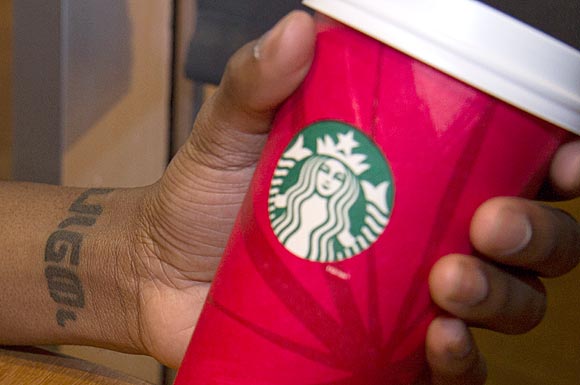It turns out they’re good customer service, he says.
Starbucks barista Myron Mayne has tattoos on both his wrists, but until recently he had to cover them up with sweatbands at work. That changed last month.
“I had a person come in and ask, ‘What is your tattoo of?’” Mayne said. ‘I said, ‘It means perseverance in Hebrew,’ and then they asked, ‘Why did you choose this?’ It’s a conversation starter.”
On Oct. 20, the coffee company changed its policy to “allow employees to show non-offensive visible tattoos, as long as they are not on the face or throat,” according to a petition created on coworker.org that called on the company to revise it’s dress code. More than 25,500 people have signed it since it was created three months ago.
But Mayne’s experience is relatively uncommon. Although tattoos have become more mainstream, many employers remain hesitant to hire individuals with visible body modifications, said Jai Colin-Thome, the laser technician at Tattoo Removal Canada.
“A client came in and he’s in his 60s and works for the Government of Canada,” she said. “He said even though he has a tattoo, if he saw a candidate with a tattoo and someone without one, he’s more likely to hire the person without it.”
Job opportunities rank as the third leading reason individuals approach Colin-Thome to get a tattoo removed, she said. The first is fading a tattoo to get a new one on top of the old ink and the second is removing a name because of a failed relationship.
Tattoo artists should debrief clients on the placement of their tattoos and how it can impact their future job prospects, Colin-Thome said.
“At the end of the day it is the individual’s choice but I do feel the tattoo artist should feel a little responsible for putting this permanent ink on somebody’s body,” she said.
Not all tattoo artists in Toronto operate this way, Mayne said, adding people should research who they’re allowing to ink their bodies.
“I think more artists should care,” he said. “You should go to an artist that makes you really think about the placement before you do it, not someone who wants the money to keep their business open.”
That’s the approach artist Lee Larabie of the Red Dragon Tattoo Parlour takes with clients wanting visible tattoos.
“I’ll say: “No. I don’t want to ruin your future. You have to think about any job you might have. For example, in customer service, you’re not going to get a good job with tattoos all over your hands. People will fear you,’” she said.
But in Mayne’s case, Starbucks’ new policy allowing him to show his wrist tattoos has proved to be positive.
“That’s my way of connecting with customers and they remember me for it,” he said. “They’ll come in again and ask, ‘Have you gotten any more tattoos?’”

